"Ivan the Fool" (also known as "Ivan the Fool and his Two Brothers") is an 1886 short story (in fact, a literary fairy tale) by Leo Tolstoy, published in 1886. The name "Ivan the Fool" alludes to a popular hero of Russian folklore.
Contents
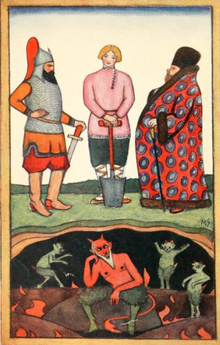

"Ivan the Fool" (also known as "Ivan the Fool and his Two Brothers") is an 1886 short story (in fact, a literary fairy tale) by Leo Tolstoy, published in 1886. The name "Ivan the Fool" alludes to a popular hero of Russian folklore.


It describes the struggles of three brothers and a sister, the offspring of a rich peasant, against the Old Devil:
Simeon and Tarras leave the family farm. Simeon becomes a great soldier and marries a noble's daughter, but despite being granted an estate and high rank, runs out of money because of his spendthrift wife. He goes home and demands a third share of his father's wealth. His father is unwilling to do so, as Ivan and Martha are the ones who helped him prosper, but Ivan has no objection, and Simeon receives his share.
Tarras becomes a rich merchant. However, his greed drives him to also insist on his share. His father objects, but Ivan again readily agrees to his brother's demands.
The Old Devil is greatly displeased that, due to Ivan's generosity, there is no conflict between the brothers, so he assigns a little devil to each brother to cause trouble. Simeon's devil fills him with excessive courage, leading to a disaster on the battlefield. For his failure, Simeon is scheduled for execution, but escapes from prison and returns home. The devil assigned to Tarras inflames his greed; he spends all of his money and borrows more to buy goods. He cannot pay back the loans, so he too flees home. Neither brother treats Ivan with any respect.
The third devil makes Ivan sick and sees to it that his plowing becomes much more difficult, but Ivan just works harder and overcomes the obstacles. Ivan discovers his little devil and is about to kill him, but the devil offers a wish in exchange for his life. Ivan wishes to be cured of his sickness. The devil heals him with a root. With that accomplished, Ivan lets the devil go, but by innocently blessing him in God's name causes the devil to disappear. Simeon's devil, his assigned work finished, plagues Ivan, but Ivan finds him too, and the same sort of thing happens. For sparing his life, the devil shows Ivan how to create soldiers from straw. Once again, Ivan lets him go with God's blessing, causing the devil to vanish. The third devil suffers the same fate, after showing Ivan how to make gold using oak leaves.
Ivan invites his brothers to a feast, but they decline, so Ivan hosts the village peasants. He gives them gold coins, then creates soldiers to sing and dance for them, before turning the soldiers back into straw. When Ivan's brothers find out what he can do, he conjures up an army for Simeon and bushels of coins for Tarras. Simeon conquers a kingdom, while Tarras has plenty of money, but they are not satisfied. They go to Ivan and demand more soldiers and gold. This time, however, Ivan refuses, as he has learned that they have caused misery with his gifts. Simeon then gives Tarras half his kingdom in exchange for half of Tarras's gold.
One day, the Czar's daughter becomes ill. The Czar offers a rich reward and her hand in marriage to any man who can cure her. Ivan gives his last magic healing root to an ailing old woman, but still goes to see the daughter. The instant he reaches her balcony, she is cured. They are married, and when the Czar dies, Ivan has a kingdom, just like his brothers.
Simeon is feared by all, while Tarras still collects taxes, despite having more money than he needs. Ivan, on the other hand, does not enjoy being a ruler. He sends for his parents and sister and resumes his old life. His wife, after thinking it over, joins him.
The Old Devil becomes impatient, waiting for his little devils to return, and sets out to do their job himself. He shows Simeon how to strengthen his army. Simeon conquers a neighboring country, but when he attacks India, he is defeated. The Old Devil then sets up as a merchant in Tarras's kingdom. He pays more than Tarras for workers and goods, no matter how much Tarras offers, so Tarras's money is useless.
The Old Devil goes to Ivan disguised as a General and offers to form a powerful army from his subjects. Ivan does not object, but his people are not interested, and Ivan does not force them to enlist. The Old Devil then incites the ruler of another country to invade, but Ivan's people are fools like him (the wise having fled Ivan's rule) and treat the invaders so well that the soldiers all desert. The Old Devil then transforms himself into a nobleman and offers to build Ivan a palace and factories. At first, the people work for him, but once they have enough gold, they stop. They will not even sell him any food. He then spends days talking to the people, to instruct them on how to use their brains rather than their hands to do their work, but they are unimpressed. When he becomes faint from hunger, he asks for bread. They laugh at him, and he collapses. Defeated, he disappears through a hole in the ground.
Although the story is usually considered a children's fairy tale, it is also used as an indication of Tolstoy's political leanings in support of Christianity.[ citation needed ] Though his brothers are easily tempted by money and military power, unsophisticated Ivan, with his simple way of life, defeats the treacherous devil. Ivan eventually becomes the ruler of the country despite the lack of a standing army or currency. All of the citizens are welcome at Ivan's table, where workers are fed first and intellectuals (those without calluses on their hands) have to eat the leftovers.

The Brothers Karamazov, also translated as The Karamazov Brothers, is the last novel by Russian author Fyodor Dostoevsky. Dostoevsky spent nearly two years writing The Brothers Karamazov, which was published as a serial in The Russian Messenger from January 1879 to November 1880. Dostoevsky died less than four months after its publication. It has been acclaimed as one of the supreme achievements in world literature.

The Tale of Tsar Saltan, of His Son the Renowned and Mighty Bogatyr Prince Gvidon Saltanovich and of the Beautiful Swan-Princess is an 1831 fairy tale in verse by Alexander Pushkin.
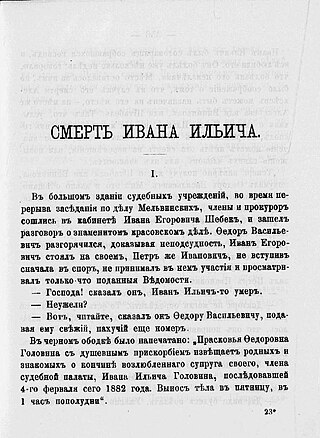
The Death of Ivan Ilyich, first published in 1886, is a novella by Leo Tolstoy, considered one of the masterpieces of his late fiction, written shortly after his religious conversion of the late 1870s.

Ivan the Fool, composed in 1913 by César Cui, is an opera-fairytale made for children in three tableaux. The libretto was written by Nadezhda Nikolaevna Dolomanova using Russian folk tales.

"Bearskin" is a fairy tale collected by the Brothers Grimm. A variant from Sicily, "Don Giovanni de la Fortuna", was collected by Laura Gonzenbach in Sicilianische Märchen and included by Andrew Lang in The Pink Fairy Book. Italo Calvino included another Italian version, "The Devil's Breeches" from Bologna, in his Italian Folktales.

"The Devil and his Grandmother" or "The Dragon and His Grandmother" is a German fairy tale collected by the Brothers Grimm, number 125. According to Jack Zipes, the source of the story was Dorothea Viehmann, the wife of a tailor from Hesse.
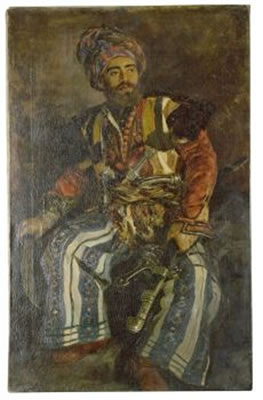
The Cossacks is a short novel by Leo Tolstoy, published in 1863 in the popular literary magazine The Russian Messenger. It was originally called Young Manhood. Both Ivan Turgenev and the Nobel prize-winning Russian writer Ivan Bunin gave the work great praise, with Turgenev calling it his favourite work by Tolstoy. Tolstoy began work on the story in August 1853. In August 1857, after having reread the Iliad, he vowed to completely rewrite The Cossacks. In February 1862, after having lost badly at cards he finished the novel to help pay his debts. The novel was published in 1863, the same year his first child was born.
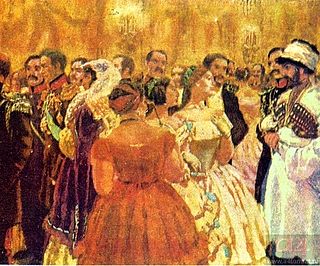
Hadji Murat, also written Hadji Murad is a novella written by Leo Tolstoy from 1896 to 1904 and published posthumously in 1912. Its titular protagonist Hadji Murat is an Avar rebel commander who, for reasons of personal revenge, forges an uneasy alliance with the Russians he has been fighting.
"Quench the Spark" is a short story by Russian author Leo Tolstoy first published in 1885. The story takes the form of a parable concerning the virtues of reconciliation.
"God Sees the Truth, But Waits" is a short story by Russian author Leo Tolstoy first published in 1872. The story, about a man sent to prison for a murder he did not commit, takes the form of a parable of forgiveness. English translations were also published under titles "The Confessed Crime", "Exiled to Siberia", and "The Long Exile". The concept of the story of a man wrongfully accused of murder and banished to Siberia also appears in one of Tolstoy's previous works, War and Peace, during a philosophical discussion between two characters who relate the story and argue how the protagonist of their story deals with injustice and fate. Along with his story The Prisoner of the Caucasus, Tolstoy personally considered this work to be his only great artistic achievement.
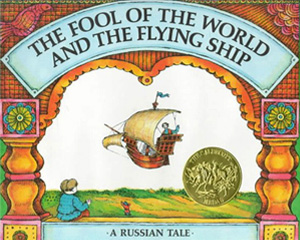
The Fool of the World and the Flying Ship is a children's picturebook illustrated by Uri Shulevitz that retells an Eastern European fairy tale of the same name. The text is taken from Arthur Ransome's version of the story in the 1916 book Old Peter's Russian Tales; Ransome had collected the folktale when he was a journalist in the Russian Empire. The book was released in 1968 by Farrar, Straus and Giroux and won a Caldecott Medal for illustration in 1969.

"Godfather Death" is a German fairy tale collected by the Brothers Grimm and first published in 1812. It is a tale of Aarne-Thompson type 332.
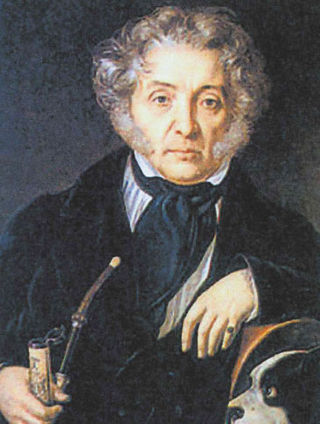
Count Fyodor Ivanovich Tolstoy, also known as "the American", was a Russian nobleman from the well-known Tolstoy family. Possessed of an unusual temper, he became famous for his gambling, his passion for duels, and his voyage to North America, where he earned his nickname. He was acquainted with many famous authors of his period and served as a prototype for some of the characters in their works.
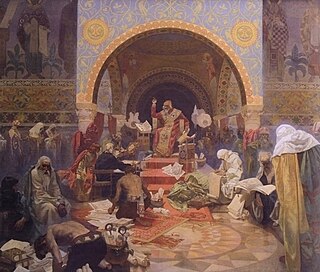
Tsar, also spelled czar, tzar, or csar, was a title used by Slavic monarchs. The term is derived from the Latin word caesar, which was intended to mean "emperor" in the European medieval sense of the term—a ruler with the same rank as a Roman emperor, holding it by the approval of another emperor or a supreme ecclesiastical official —but was usually considered by Western Europeans to be equivalent to "king". It lends its name to a system of government, tsarist autocracy or tsarism.

"After the Ball" is a short story by the Russian writer Leo Tolstoy, written in the year 1903 and published posthumously in 1911. The short story serves as an example of Tolstoy's commentary on high culture and social governance, as explored through one man's experience with love.

"The Grave Mound" is a German fairy tale collected by the Brothers Grimm, KHM 195. It is Aarne-Thompson type 779, Divine Rewards and Punishments.

The Devil's Sooty Brother KHM 100 is a German fairy tale collected by the Brothers Grimm and published in the second edition of Kinder- und Hausmärchen in 1819. It is a tale of Aarne–Thompson type 475, "Heating Hell's Kitchen", or "The Man as Heater of Hell's Kettle".
Brother Lustig KHM 81 is a lengthy German fairy tale collected by the Brothers Grimm and published in the first edition of Kinder- und Hausmärchen in 1812. It contains elements of Aarne–Thompson type 785: Who Ate the Lamb's Heart?; type 753A: The Unsuccessful Resuscitation; type 330B: The Devil in the Sack; and type 330: Entering Heaven by a Trick.
Twenty-Three Tales is a popular compilation of short stories by Leo Tolstoy. According to its publisher, Oxford University Press, the collection is about contemporary classes in Russia during Tolstoy's time, written in a brief, morality-tale style. It was translated into English by Louise Maude and Aylmer Maude.